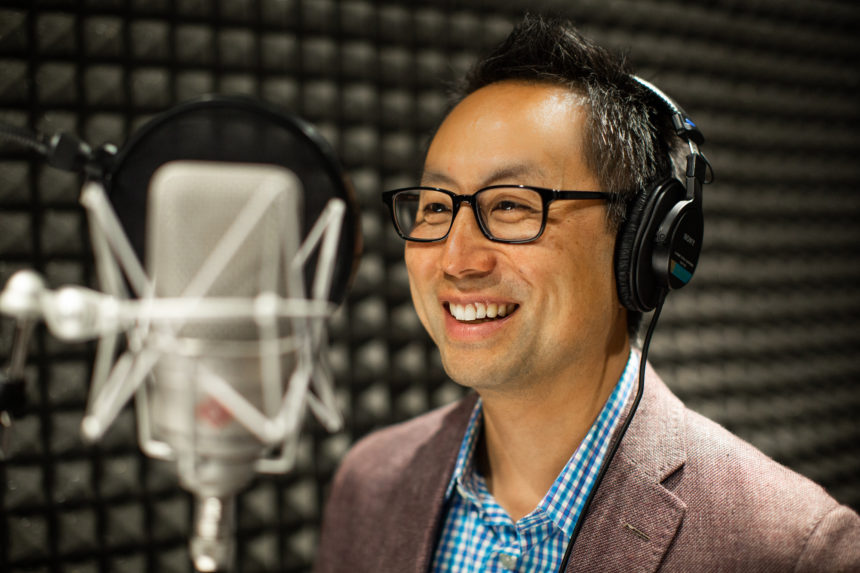The podcast industry was booming long before COVID-19 hit, with health-oriented pods generating considerable enthusiasm among listeners and advertisers alike. But even as the March 2020 shutdown eliminated or shortened many commutes — and thus one of the primary listening times for audio enthusiasts — it created a fertile new content category: the pandemic pod.
While health- and science-focused podcasts such as Eli Lilly’s Elixir Factor had generated loyal audiences well before the pandemic, our new reality has had a halo effect on such offerings — not to mention their creators. Pharma companies, which have been viewed with wariness by the public, saw their reputations soar.
As a result, an already thriving segment of the channel has been kicked into overdrive. “COVID really spiked the consumption of podcasts,” says Guidemark Health engagement lead Jackie Singley. “People were walking more and were at home more, and had more time to explore things such as podcasts.”
According to Edison Research’s Infinite Dial, which tracks digital media consumer behavior, the number of Americans who have listened to a podcast has been steadily climbing each year since 2006. By 2020, an estimated 55% of Americans had listened to at least one podcast, a rise from 51% in 2019.
But while many organizations are pouring money into the channel, only a small fraction are gaining traction — not to mention generating significant revenue. According to a recent Axios report using data from the PwC Global Entertainment & Media Outlook, the top 1% of podcasts generate 99% of all downloads.
It may be rare for a new podcast to hit the jackpot and ascend into that exalted top percentile, especially given the podcast world’s increasing saturation. But that hasn’t slowed healthcare marketers from seizing the increasing number of opportunities the channel provides — and finding creative ways to use it to forge deeper connections with their consumers.
“It’s an influential channel,” Singley notes. “It’s also a very active and engaged channel. Those who listen to podcasts are loyal, heavy consumers of content in that format.”
That very devotion is central to the appeal of podcasts to healthcare marketers looking to elevate their brands, or even just to forge stronger connections with their consumers. To that end, 54% of listeners are likely to buy from brands they hear advertised on their favorite podcasts, according to Edison Research.

Science and innovation play especially well in the podcast space. One of the pharma pod world’s best-regarded offerings, Eli Lilly’s Elixir Factor, focuses on scientific advances, research, tech and advocacy around the search for disease treatments and cures. It offers the company and its people a way to showcase their work while simultaneously framing it as part of a greater storytelling whole. Its appeal extends from patients and caregivers to physicians, advocates and just about every other member of the broader healthcare community.
Even beyond the opportunity the podcast medium provides from a content perspective, the barriers for entry are low. Some podcasts up the production-value ante, but the great majority take the bare-bones approach: a few guests, a few microphones and an unvarnished emphasis on conversation. Deep financial reserves are not part of the price of admission.
At the same time, monetizing podcasts has proven a challenge for even the savviest publishers, in health and in other verticals alike. When it comes to creating effective brand marketing in the podcast format, challenges abound. While there’s some degree of flexibility in terms of the length of ads, many marketers want to push the envelope further than publishers are willing to go.
However, from a content perspective, pharma can’t get enough of the podcast era. Pfizer, for its part, took advantage of the company’s reputation boost in the wake of its first-to-market COVID-19 vaccine. Based on the success of The Antigen, which delved into the broader scientific and cultural aspects of vaccination, Pfizer launched a spinoff of sorts focused solely on COVID-19.

Both iterations were true to the company’s communication ethos. In 2019, when the first season of The Antigen debuted, the content team was fueled by a desire to “help advance the public conversation around vaccines — to provide factual, science-based information in a digestible format,” according to Nanette Cocero, global president of Pfizer vaccines.
That experience — scientific and otherwise — came in handy when the coronavirus arrived on U.S. shores in March 2020. Not surprisingly, the COVID-19-focused season finds host Lindsey Dietschi discussing all aspects of the pandemic with Pfizer scientists and other experts in global health.
“When our original, eight-episode series came to an end in March 2020, we felt we couldn’t ignore this new element to the story we had set out to tell — and given the significant role of Pfizer and the pharmaceutical industry in helping to address the COVID-19 crisis, we felt we had an important perspective to bring,” Cocero recalls.
Pfizer tweaked the established Antigen format for the COVID-19 miniseries. The goal was to be “a bit more nimble” in its approach, Cocero adds.
“We saw it as a natural extension of the first season and the conversation about society’s ongoing fight against infectious disease. It was clear from the first season that many people recognized the need for this kind of thoughtful discussion around vaccines and embraced the opportunity to address misinformation with scientific evidence.”
Pfizer’s timing was fortunate: The Antigen started gaining traction right around the time that vaccines became a top-of-mind concern for a great percentage of the U.S. population. Meanwhile, the podcast format offered the Antigen team a chance to develop content
that was more in-depth and thought-provoking than might have been possible in other channels.
“The vaccines story is timely and complex, and not something that can be fully captured in a short video clip or sound bite alone,” Cocero says. “Podcasting presented a unique opportunity to convene a diverse set of voices and deep dive into this topic, and that resonated with our audience.”

Johnson & Johnson’s nursing-focused podcast See You Now was launched in early 2020, right before the pandemic hit — but it didn’t take long for the team to pivot from discussing topics such as the gamification of healthcare and clinician burnout. In came a newly focused series of episodes, “COVID-19: The Nurse Response,” which delved into telehealth, the plight of frontline providers and the pandemic’s effect on mental health.
“We soon realized that COVID-19 was going to wreak havoc and that nurses would be at the center of the storm,” says Lynda Benton, senior director of corporate equity at Johnson & Johnson. “We knew we needed to act quickly. Refocusing our content on COVID-19 was mission-critical.”
The decision to focus on the role of nurses during the pandemic helped See You Now build a strong listenership; that particular topical hook differentiated it from most everything else COVID-related on the podcast market. At the same time, See You Now covers more than enough general healthcare topics to engage a wider audience beyond the nursing profession itself.
“The broad range of issues the podcast is covering, such as health technology and access to care, has expanded our listenership to include decision-makers in the healthcare space, entrepreneurs in the VC community and other healthcare workers,” Benton reports.
To further grow the listenership of See You Now, Johnson & Johnson’s marketing team used targeted paid media focused on the core nursing audience (ironically, including ads on other podcasts) as well as plugs delivered via social media.
“While we see nurses as our core audience, we knew that speaking to non-nurses, including health administrators, policy makers and the general public, is also incredibly important if we want to help change the perception of nurses and the role they play,” Benton adds.
The podcast also offered Johnson & Johnson an opportunity to support vaccine education. Based on the results of a COVID-era American Nurses Association survey, the team identified a need for nurses to be armed with more scientific information about vaccines. They chose to use that as the basis of a special See You Now episode showcasing advocates, experts and innovators discussing vaccine safety.
While several other pharma players have pivoted their podcasts to COVID content in the last year, the trend will likely outlast the pandemic, says Genentech senior manager of science communications Stephanie Huang, who produces the Two Scientists Walk Into a Bar podcast.
“We anticipate podcasts will continue to grow in popularity, and that growth may accelerate during COVID-19 because podcast production can be readily adapted to remote working situations,” she explains. “The key challenge for marketers and communicators remains how to develop and create compelling content so that their podcast stands out.”
One way to do that is by engaging with condition-specific communities and tapping their experience and enthusiasm for podcast fodder. Singley expects that future growth in and around podcasts will stem from such efforts.
“The beauty of podcasts is in bringing together those communities,” she notes.
For an organization such as Guidemark, podcasting gives its leaders and clients — and, by extension, listeners — a proverbial seat at the table with medical experts. Because the company works in the realms of cancer and rare disease, the in-depth, storytelling-centric format of podcasts is an ideal fit for many clients.
“The creators can connect their audience directly with leaders who are in the science industry and bring them credibility and content,” Singley explains. “Podcast creators have the ability to reach the newly diagnosed and reach survivors — and people are loyal to these creators.”
Along those lines, recently diagnosed patients who are looking to learn more about their conditions may find themselves overwhelmed with online information. Enter the podcast, which offers an intimate format bolstered by scientific credibility and expert voices. Connections can be forged easily and naturally.
And podcasting can prove a boon to the companies that create them as well. “When you’re starting out doing patient journey work, you can tap into this channel to explore patient conversations,”
Singley says. “You can learn from people who are sharing what living with a condition is really like.”
From the April 01, 2021 Issue of MM+M - Medical Marketing and Media








